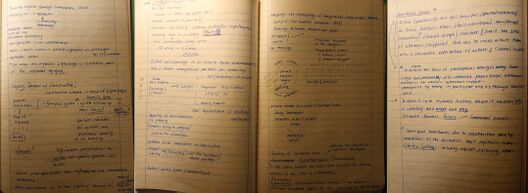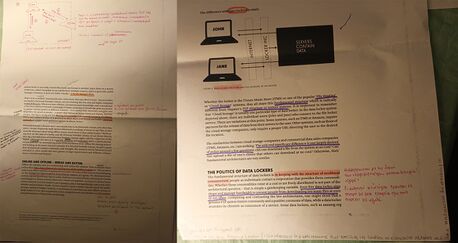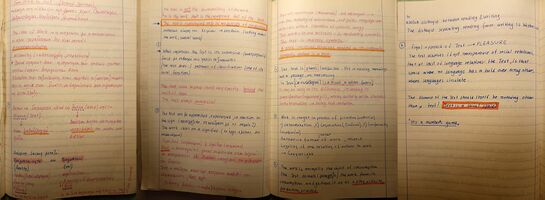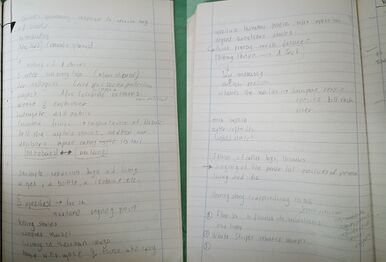The Methods, the Readers, the Texts
W H Y | W H A T | H O W
HOW DO WE LIBRARY THAT???
Bootleg Library
https://hub.xpub.nl/bootleglibrary/shelf/96
Mapping Beyond Dewey's Boundaries: Constructing Classificatory Space for Marginalised Knowledge Domains | Hope A. Olson
"Moving from silence into speech is for the oppressed the colonised, the exploited in those who stand and struggle side by side a gesture of defiance that heeals that makes new life new growth possible. it is the act of speech, stalking back that is no mere gesture of my words that is the expression of our movement from object to subject the "liberated voice.", Bell Hooks
The way we organize knowledge is essential part of the cultural memory
Sayers " manual of classification"
Classification scheme---> map of knowledge
Cornell's idea-- boundless system system defined by the limits post-structuralist
Multiple realities no system can represent reality in it's totallity
Η ταξινόμηση καταδεικνύει τη σχέση ενός κλάδου γνώσης με έναν άλλο
Σχέση χαρτογράφησης και ταξινόμησης ως κοινωνικές κατασκευές!
Maps consider to be the limits of the world
Distort all knowledge is infinite multi diamonds dimensionality into ε linear arrangement suitable for browsing list locations on shelves
Mapping as representations of property terrains belong someone
Quality of constructed space
Is the extent to which the index term reflects the precise content of the item of information. Pigeon holes performed without reference to the subjects of particular documents based on the structure of the system in comparison with co extensiveness which is dazed on the subjects of individual documents.
Rhetorical spaces(to deflect the folks Sofia Sophie call analysis away from singing and presumably self-contained propositional you terence's pronounced by no one in particular and as though neutral space)
Fictive φανταστικός but not fanciful φαντασιόπληκτος or fixed locations whose tacit territorial imperative structure and limited the kind of answers that can be voiced within them with a reasonable expectation of uptake and coral support.
--> to move it into textured locations where it matters who is speaking and where and why discourse becomes Poiesis (communal process)
Space have boundaries due to construction by imperatives of the discourses that construct them.
Limited systems including concepts excluding others.
This apparently neutral space is like postmodern theorist Henri Lefebvre transparent space which denies the existence of anything excluded from snapping because it appears to be all there is. "Transparent" space is the illusion that location is neutral' that mapping territory can be a 'true' representation of some a sense of reality as Brooks suggests. Space husband Aries and always includes and excludes something it cannot be neutral. Making the exclusions visible means identifying the space boundaries to allow recognition of what is outside those boundaries. It is identifying the implied opposite of a deconstructive binary opposition. It shows the constructed nature of the space. It moves the discourse into Texas locations word mothers who is speaking and where and why and where such monitoring bears directly upon the possibility of knowledge claims.
Poiesis a way of presenting experience reality that remains and alters it in the process
Classification remakes and altars information by constructing a particular context for it. Gathering scattering and juxtaposing topics in relation to each other.
The creation of classification creates the space in which some knowledges are central and others are peripheral.
Radical Tactics of the Offline Library (It's a numbers game) | Henry Warwick
Image Music Text (From Work to Text) | Ronald Barthes
From work to text
The Text is not to be thought of as an object that can
be computed. It would be futile to try to separate out
materially works from texts. I The difference is this: the work is a
fragment of substance, occupying a part of the space of books
the text is a process of demonstration, speaks according
to certain rules (or against certain rules);
(in a library for example), the Text is a methodologicalfi eld. the one is displayed (εκτείθεται), the other demonstrated
only exists in the movement of a discourse (or rather, it is
Text for the very reason that it knows itself as text); the
Text is not the decomposition of the work, it is the work that
is the imaginary tail of the Text; or again, the Text is
experienced only in an activity of production. It follows that
the Text cannot stop (for example on a library shelf);
its constitutive movement is that of cutting across (in
particular, it can cut across the work, several works).
2. In the same way, the Text does not stop at (good)
Literature; it cannot be contained in a hierarchy, even in a
simple division of genres. What constitutes the Text is, on
the contrary (or precisely), its subversive force in respect of
the old classifications. How do you classify a writer like
Georges Bataille? Novelist, poet, essayist, economist,
philosopher, mystic? The answer is so difficult that the
literary manuals generally prefer to forget about Bataille
who, in fact, wrote texts, perhaps continuously one single
text. If the Text poses problems of classification (which is
furthermore one of its 'social' functions), this is because it
expression from Philippe Sollers).
The word is a virus - Burroughs
https://www.youtube.com/watchv=KvOoR8m0oms&ab_channel=stereomusicvideo
“The word is now a virus. The flu virus may have once been a healthy lung cell. It is now a parasitic organism that invades and damages the central nervous system. Modern man has lost the option of silence. Try halting sub-vocal speech. Try to achieve even ten seconds of inner silence. You will encounter a resisting organism that forces you to talk. That organism is the word.”
Donna Haraway's response to Ursula Le Guin's Carrier Bag
Moya Davey, Fifty minutes
https://www.ubu.com/film/davey_50.html
Fugitive Libaries | Shannon Mattern
The Undercommons: Fugitive Planning & Black Study
She Unnames Them | Ursula K. Le Guin
Ursula K. Le Guin 1986 The Carrier Bag Theory of Fiction
Mutual Aid | Peter Kropotkin (1912)
Hyperworld | Ted Nelson
The Future of Writing |
Paper Machines (Thinking in Boxes) | Markus Krajewski
Kleist ’ s idea is that communication partners need a catalyst to attain clarity about the knowledge to be expressed. What does the mere presence of an interlocutor achieve? “ The midwifery of thought ” — a term Kleist borrowed from Kant. Without a counterpart, intellectual bankruptcy looms, as in the case of Heine ’ s friend G., but with a partner, wealth beckons. It is no coincidence that early collections of analects and excerpts from all readings date from the same era as the paper banks of the sixteenth century.
According to Kleist, the human face serves as a sufficient source for inspiration; a look that conveys comprehension of a half-expressed thought is suffi cient. One could assume that looking at wooden drawers is hardly inspiring. However, substitute the “ interface ” between person and appara-tus for the “ human face ” — and substitute for the simple word “ gaze ” the word “ brush. ” For it is the light touch of index cards, the interplay with the silent interlocutor, that gives birth to a thought, prompting the inter-locutor to actually speak and provide “ witty responses ” after all, to use Kleist ’ s phrase. The box of index cards offers an interface that is more than just a stimulating sight, as the apparatus, upon the lightest touch, delivers keywords that stimulate the protagonist to further production of thought. Thus, a silent counterpart can grow into an actual interlocutor. The fact that the keywords offered seem by no means arbitrary is guaranteed by a widespread net of cross-references, for both partners. Bit by bit, during the course of their interaction, connections accumulate in the apparatus as a “ kind of second memory. ” 70 And this second memory gains a certain amount of independence if it intervenes in the thought process of its thoughtful user more thoroughly than Kleist suggested.
Exploratory Programming: Calculating and using Jupyter Notebook
Writing Machines (Technotexts) | N. Katherine Hayles
Why to use metaphor? μεταφέρω = bearing across
"denotes transfer of sense associated with one word to another. The transfer between a symbol (network of symbols) and a material apparatus. Symbol-processing machines we call computers. Material metaphor --> a term that foregrounds a traffic between words and physical artifacts. "
"Book as material metaphor but in fact it is an artifact whose physical properties and historical usage structure our interactions with in ways obvious and subtle."
list of MACHINES, TOOLS, THE MATERIALISATION
** "to change the physical form of artifacts is to change the act of reading, but profoundly to transform the metaphoric network structuring the relation of world to world.
To change the material artifacts is to transform the context and circumstances for interacting with the words, which inevitably change the meaning of the word as well. This transformation of meaning is especially potent when teh words reflexively interact with the inscription technologies that produce them"
----
Literary works that strengthen, foreground, and thematize theconnections between themselves as material artifacts and the imagina-tive realm of verbal/semiotic signifiers they instantiate open a window onthe larger connections that unite literature as a verbal art to its mate-rial forms. To name such works, I propose “technotexts,” a term that connects the technology that produces texts to the texts’ verbal con-structions. Technotexts play a special role in transforming literary crit-icism into a material practice, for they make vividly clear that the issueatstake is nothing less than a full-bodied understanding of literature.
All of the technotexts I discuss in this book could also be called hypertexts. Hypertext has at a minimum the three characteristics of MULTIPLE READING PATHS,CHUNKED TEXT, and some kind of LINKING MECHANISM to connect the chunks.
Writing (The future of Writing) | Vilem Flusser
Writing is an important gesture, because it both articulates and produces that state of mind which is called “historical consciousness.” History began with the invention of writing, not for the banal reason oftenadvanced that written texts permit us to reconstruct the past, but for themore pertinent reason that the world is not perceived as a process, “historically,” unless one signifies it by successive symbols, by writing.
If one examines certain Mesopotamian tiles, one can see that the original purpose of writing was to facilitate the deciphering of images.Those tiles contain images impressed upon them with cylindrical sealsand “cuneiform” symbols scratched into them with a stylus.
It may be shown through text analysis that the original pur-pose of writing, namely, the transcoding of two-dimensional codes into asingle dimension, is still there: every text, even a very abstract one, means,in the last analysis, an image.
The purpose of images is to mean the world, but they may become opaque to the world and cover it,even substitute for it. They may come to constitute an imaginary world that no longer mediates between man and the world, but, on the contrary, imprisons man. Imagination no longer overcomes alienation, but becomes hallucination, or double alienation. No longer are such images tools, but man himself becomes a tool of his own tools; he “adores” theimages he himself has produced. It is against this idolatry of images, as atherapy against this double alienation, that writing was invented. Theearly writers in our tradition—the prophets, for instance—knew this bycommitting themselves against idols and idol making. And so did Platowhen he announced his hatred of what we now call the “plastic arts.”Writing, historical consciousness, linear, rational thought were inventedto save humankind from “ideologies,” from hallucinatory imagination.
The purpose of writing is to mean, to explain images, but texts may be-come opaque, unimaginable, and they then constitute barriers betweenman and the world. (...)Such unimaginable explanations that mirror the structure of literate thought are existentially devoid of meaning, and in such a situation texts begin to constitute akind of paranoid library wall that triply alienates man from his world.
TECHNO-IMAGES
Un-/Learning Archives in the Age of the Sixth Extinction
https://wholelife.hkw.de/un-learning-archives-in-the-age-of-the-sixth-extinction/
"In thinking more about gardens as overlapping sites of history, legacy, and testimony, sustainable gardening systems, such as seed keeping and perennial plantings become metaphorical approaches to reconnecting with distant relatives and beloved homelands. Gardening is important, but seed saving is crucial. Gardeners frequently save seeds as an attempt to grow a better crop the next year, save money, and in order to trade with others. However, a seed holds more than its genetic logic. Seeds hold memory. For many, seeds are vessels for belief and hope.
Over the years, the gardener maintains a reciprocal exchange with plants—cultivating an intimate relationship to the earth, preserving memories of years before, and observing their own personal transformation in the process. How can gardening serve as a reminder of one’s cultural heritage and identity? How can seed saving make stories and traditions more widely known? How can seeds bring invisible legacies to the forefront? Seeds are relatives. They prompt discussions on creation, belonging, and heritage. Seeds are a living archive and therefore ask us how archives can become more participatory and serve as a transmission of history rather than being frozen or fixed. Seeds communicate physical, historical, and cultural relationships as they relate to agriculture. Some of us collect and carry seeds in an attempt to cultivate our “homelands” elsewhere. There is a growing inter-generational movement of Indigenous peoples who are leading the rematriation of seeds in order to repair and heal after more than 500 years of separation, removal, and colonization. Seeds are coming home."
"Even if academia reframes white settler worldviews away from discrete models of expertise toward collective systems and knowledge production as planetary, what now? Even if we shift from white settler demands anchored in colonial-capitalist conquest and extraction toward responsibility to the environment and sustaining earth’s ecosystems through understanding the planet as an interdependent, holistic system, how then, to preserve Earth as an archive without getting lost in its imitations, either by virtual worlds or by terraforming other planets to its likeness? How do we avoid typologies that oversimplify lived experiences? How do these things become urgent—rather than conceptual—in climate catastrophe, in the apocalypse?
So, then, for the purposes of this workshop outcome, what would it mean to consider an archive as an antidote to extinction? Or— again—what might it mean to feel or read the planet as archive? What kind of (exploratory, conceptual, creative, practical) project is it to undertake the preservation of everything— to acknowledge that to preserve one thing we must preserve all things? What gets to be saved? Whose memory? For what future? What is the role of the earthly archive of human and more-than-human experiences when the future is this uncertain?"
The Public Library as Instrument of Colonialism: The Case of the Netherlands East Indies
libraries were used as colononization instruments- in the specific case of Netherlands 's colonies (since I happened to be here).
Interested reading: https://www.jstor.org/stable/25549496
"The Ethische Politiek (Ethical Policy), enacted in 1900, mandated a variety of programs intended to benefit Indies colonial subjects and the new capitalist direction of the colonial economy. Among them was an expansion of native education, designed to prepare Indies natives to enter the workforce.
Taman Pustaka in Indonesian language means Garden of Reading and means Library.
entertaining material in order to retain the habit of reading. Since Balai Pustaka books, journals, and almanacs would constitute a monopoly on published material in the villages, why not make sure these reading materials taught the "right" values?
By the early 1920s Balai Pustaka was publishing original novels in lo cal languages, translations of European juvenile adventure books, and versions of local stories and epics. Its original novels were closely moni tored for religious and political comment, and descriptions of immoral behavior were forbidden as well. The situation in a stereotypical Balai Pustaka novel is a (young, modernized) character's conflict with some aspect of adat (customary law). Values such as cleanliness and depend ability and consumer goods like watches and radios are conspicuous.These novels consciously undermined tradition and guided their readers toward their positions as salaried consumers in the new colonial regime. Similarly, translated European novels originally intended for adolescents were notable for their "safeness." Versions of tales from the great Indian epics were reshaped with Western notions of narrative flow and personal propriety. Balai Pustaka also spread its message of Westernization through a number of periodical publications. "
E-Boooks Libraries and Feelies
An archive of Words
As We May Think
Weaving Women Cybernetics (The Future Looms)
Near Print and Beyond Paper
Pencer/Classer Perec , Σκέψη Ταξινόμηση
Χορείες Χώρων, species of spaces Perec
| Week | Title | Contributors | Link |
|---|---|---|---|
| 1: Tasks of the Contingent Librarian | Tasks of the Contingent Librarian | Simon Browne | User:Simon/Tasks_of_the_Contingent_Librarian_cards |
| 'She Unnames Them' | Ursula K Leguin | https://pad.xpub.nl/p/LeGuinAcaciaSeeds | |
| The Carrier Bag Theory of Fiction | Ursula K Leguin | https://hub.xpub.nl/bootleglibrary/book/68 | |
| 2: Print Screen | 'Introduction: Receiving Three Mochilas in Colombia, Carrier Bags for Staying with the Trouble', The Carrier Bag Theory of Fiction | Donna Haraway | https://hub.xpub.nl/bootleglibrary/read/778/pdf#page=14 |
| 'The Fridge, Books', Index Cards | Moyra Davey | https://hub.xpub.nl/bootleglibrary/book/767 | |
| 'In Praise of the Cross-reference" (pp 63-65), Paper Machines: About Cards & Catalogs, 1548-1929 | Markus Krajewski | https://hub.xpub.nl/bootleglibrary/read/557/pdf#page=70 | |
| 'On the Gradual Manufacturing of Thoughts in Storage' (pp 65-68), Paper Machines: About Cards & Catalogs, 1548-1929 | Markus Krajewski | https://hub.xpub.nl/bootleglibrary/read/557/pdf#page=72 | |
| Communicating with slip boxes: An Empirical Account | Niklas Luhmann | https://luhmann.surge.sh/communicating-with-slip-boxes | |
| Fugitive Libraries | Shannon Mattern | https://placesjournal.org/article/fugitive-libraries/ | |
| 3: Text, TBC | 'The General Antagonism: An Interview With Stevphen Shukaitis' (pp 103-110), The Undercommons: Fugitive Planning & Black Study | Stevphen Shukaitis, Stefano Harney, Fred Moten | https://hub.xpub.nl/bootleglibrary/read/599/pdf#page=109 |
| 'It's a Numbers Game' (pp 7-13), Radical Tactics of the Offline Library | Henry Warwick | https://hub.xpub.nl/bootleglibrary/read/366/pdf#page=9 | |
| 'From Work to Text' (pp 155-164), Image, Music, Text | Roland Barthes | https://hub.xpub.nl/bootleglibrary/read/257/pdf#page=160 | |
| 4: Scribes Getting Personal | Writing Machines, (pp 26-28) | N Katherine Hayles | https://hub.xpub.nl/bootleglibrary/read/464/pdf#page=27 |
| 'The Future of Writing' (pp 63-69), Vilém Flusser: Writings | Vilém Flusser | https://hub.xpub.nl/bootleglibrary/read/173/pdf#page=102 | |
| El Paseo Community Garden: Recognizing Our Elders and Rebuilding Intergenerational Communities | Tamara Becerra Valdez | https://wholelife.hkw.de/un-learning-archives-in-the-age-of-the-sixth-extinction/ | |
| 5: Gardening the Library | The Catalogue of Shipwrecked Books | Edward Wilson-Lee | https://hub.xpub.nl/bootleglibrary/read/791/epub |
| 6: Paper Machines | As We May Think | Vannevar Bush | https://www.theatlantic.com/magazine/archive/1945/07/as-we-may-think/303881/ and https://hub.xpub.nl/bootleglibrary/book/788 |
| 'Near Print and Beyond Paper Knowing by *.pdf' (pp 111-135), Paper Knowledge: Toward a Media History of Documents | Lisa Gitelman | https://hub.xpub.nl/bootleglibrary/read/280/pdf#page=126 | |
| 'An Archive of Words', (pp 271-305) Science in the Archives: Pasts, Presents, Futures | Daniel Rosenberg | https://hub.xpub.nl/bootleglibrary/read/732/pdf#page=280 | |
| 7: A Textile, A Framework | The Future Looms: Weaving Women and Cybernetics | Sadie Plant | https://hub.xpub.nl/bootleglibrary/read/335/pdf |
| 'E-Books, Libraries and Feelies' (pp 76-97), Computing as Writing | Daniel Punday | https://hub.xpub.nl/bootleglibrary/read/573/pdf#page=93 | |
| 8: Permutations | The Garden of Branching Paths | Jorge Luis Borges | https://hub.xpub.nl/bootleglibrary/book/107 |




